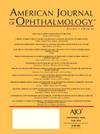女性生殖因素与剥脱性青光眼或疑似青光眼的危险有关。
IF 4.1
1区 医学
Q1 OPHTHALMOLOGY
引用次数: 0
摘要
目的发生率研究报告了女性脱屑综合征和青光眼(XFG)的发生率较高,这可能与女性特异性因素有关。我们评估了女性生殖因素与XFG事件之间的关系。设计护士健康研究(NHS) 121,098名女性的前瞻性队列研究;1980-2018)和NHSII(1991-2019)。方法入选受试者年龄≥40岁,绝经后,无XFG或白内障摘除史,有生殖因素资料,并有眼科检查报告。有医疗记录的病例440例为偶发性或脱落性青光眼疑似病例。每眼Cox比例风险模型用于估计多变量调整风险比(mvhr)和95%置信区间(ci)。错误发现率(FDR)用于校正多重比较。结果总体而言,生殖史表明终生雌激素暴露较高与XFG/XFGS风险较高相关。初潮年龄每增加1年,风险降低9% (MVHR=0.91;95%ci: 0.85, 0.97;FDR-corrected p-trend = 0.047)。胎次不相关,口服避孕药和母乳喂养持续时间较长呈负相关,绝经年龄较早和绝经期激素治疗持续时间呈负相关,尽管没有fdr校正的p趋势显著。在XFG高遗传易感性的人群中,与自然绝经相比,手术绝经(双侧卵巢切除术)与XFG/XFGS呈负相关(MVHR=0.37;95% ci: 0.15, 0.92;FDR-corrected p-interaction = 0.0007)。结论初潮年龄越晚,发生XFG/XFGS的风险越低。手术绝经与自然绝经仅在高遗传易感性人群中与XFG/XFGS风险呈负相关。这些结果有待证实。本文章由计算机程序翻译,如有差异,请以英文原文为准。
Female reproductive factors in relation to risk of exfoliation glaucoma or glaucoma suspect.
PURPOSE
Incidence studies have reported higher rates of exfoliation syndrome and glaucoma (XFG) in women, implicating female-specific factors. We evaluated associations between female reproductive factors and incident XFG.
DESIGN
Prospective cohort study of 121,098 females in the Nurses' Health Study (NHS; 1980-2018) and NHSII (1991-2019).
METHODS
Eligible participants were ≥40 years old, postmenopausal, had no history of XFG or cataract extraction, had data on reproductive factors, and reported ophthalmic examinations. Incident XFG or exfoliation glaucoma suspect (XFGS) cases (n=440 affected eyes) were confirmed with medical records. Per-eye Cox proportional hazards models were used to estimate multivariable-adjusted hazard ratios (MVHRs) and 95% confidence intervals (CIs). False discovery rate (FDR) was used to correct for multiple comparisons.
RESULTS
Overall, reproductive history indicative of a greater lifetime estrogen exposure was suggestively associated with higher XFG/XFGS risk. Each 1-year increase in age at menarche was associated with 9% lower risks (MVHR=0.91; 95%CI: 0.85, 0.97; FDR-corrected p-trend=0.047). Parity was not associated, longer durations of oral contraceptive use and breastfeeding were inversely associated, and earlier age at menopause and duration of menopausal hormone therapy was adversely associated, although no FDR-corrected p-trends were significant. Among those with high genetic susceptibility for XFG, surgical menopause (bilateral oophorectomy) was inversely associated with XFG/XFGS compared to natural menopause (MVHR=0.37; 95% CI: 0.15, 0.92; FDR-corrected p-interaction=0.0007).
CONCLUSION
Later age at menarche was associated with a lower XFG/XFGS risk. Surgical versus natural menopause was inversely associated with XFG/XFGS risk only among those with high genetic susceptibility. These results need confirmation.
求助全文
通过发布文献求助,成功后即可免费获取论文全文。
去求助
来源期刊
CiteScore
9.20
自引率
7.10%
发文量
406
审稿时长
36 days
期刊介绍:
The American Journal of Ophthalmology is a peer-reviewed, scientific publication that welcomes the submission of original, previously unpublished manuscripts directed to ophthalmologists and visual science specialists describing clinical investigations, clinical observations, and clinically relevant laboratory investigations. Published monthly since 1884, the full text of the American Journal of Ophthalmology and supplementary material are also presented online at www.AJO.com and on ScienceDirect.
The American Journal of Ophthalmology publishes Full-Length Articles, Perspectives, Editorials, Correspondences, Books Reports and Announcements. Brief Reports and Case Reports are no longer published. We recommend submitting Brief Reports and Case Reports to our companion publication, the American Journal of Ophthalmology Case Reports.
Manuscripts are accepted with the understanding that they have not been and will not be published elsewhere substantially in any format, and that there are no ethical problems with the content or data collection. Authors may be requested to produce the data upon which the manuscript is based and to answer expeditiously any questions about the manuscript or its authors.

 求助内容:
求助内容: 应助结果提醒方式:
应助结果提醒方式:


